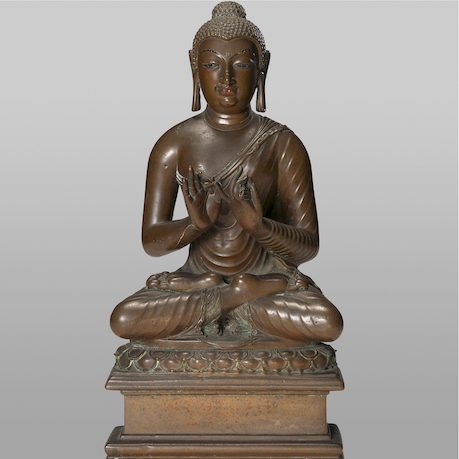
Read the transcript of this episode.
For most, deep and lasting enlightenment doesn’t come in an instant. When considering how to navigate a path of study and self-inquiry, what is important? Psychologist, author and teacher of meditation Tara Brach shares her own story of how her life took an unexpected turn, what it was like to find her own path as both a student and teacher of Buddhism, and how her spiritual journey led to one of radical acceptance and compassion.
Tara responds to a sculpture of Gautama Budda who holds his hands in a gesture of teaching known as the dharmachakra mudra, indicating the act of instruction. It originally signified the Buddha’s first teaching when he symbolically turned the wheel of the Dharma.
ABOUT THE GUEST
Tara Brach is the founder and guiding teacher of the Insight Meditation Community of Washington. She is the author of several books””including the international best-selling Radical Acceptance, True Refuge, Radical Compassion, and Trusting the Gold“”and her popular weekly podcast is downloaded over three million times each month. Along with Jack Kornfield, Tara leads the Mindfulness Meditation Teacher Certification Program (MMTCP), serving participants from around the world. Tara’s teachings blend Western psychology and Eastern spiritual practices, mindful attention to our inner life, and a full, compassionate engagement with our world.
ABOUT THE ART FROM THIS EPISODE

Seated cross-legged on a lotus, the Buddha is recognizable by his physical marks: a protuberance on top of his head (ushnisha), a whorl of hair between his brows (urna), and long earlobes stretched by heavy earrings from his renounced princely life. He holds his hands in a gesture of teaching, the dharmachakra mudra. This visual clue denotes an act of instruction and originally signified the Buddha’s first discourse when he symbolically turned the wheel of the Dharma, or his teachings.
PRODUCTION CREDITS
AWAKEN is produced by the Rubin Museum of Art with Vincent Baker, Dawn Eshelman, Jamie Lawyer, Sandrine Milet, Elena Pakhoutouva, and Dawnette Samuels. It was produced in collaboration with Sound Made Public, with Tania Ketenjian, Katie McCutcheon, and Philip Wood.
Special thanks to Karen Sorensen for additional consulting.
All music for AWAKEN was created by Blue Dot Sessions, Podington Bear, Tendinite, and Siddhartha Corthus.
OUR GENEROUS SUPPORTERS
This podcast is supported by Barbara Bowman, the Ellen Bayard Weedon Foundation, The Prospect Hill Foundation, Bob and Lois Baylis, public funds from the New York City Department of Cultural Affairs in partnership with the City Council, and by the New York State Council on the Arts with the support of Governor Andrew M. Cuomo and the New York State Legislature, as well as by generous donations from the Museum’s Board of Trustees, individual donors, and members.
AWAKEN is sponsored by Tricycle: The Buddhist Review, a print and digital magazine dedicated to making Buddhist teachings broadly available.



